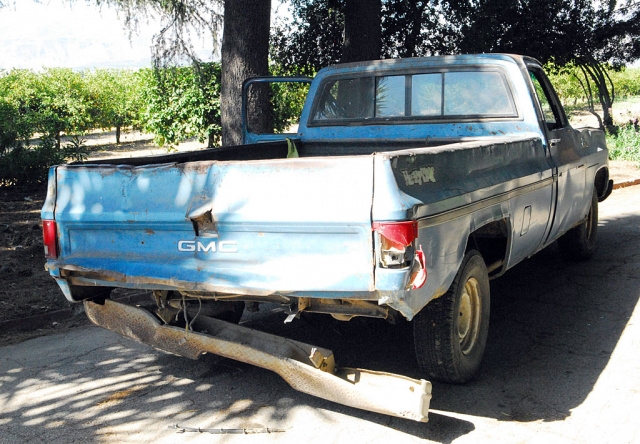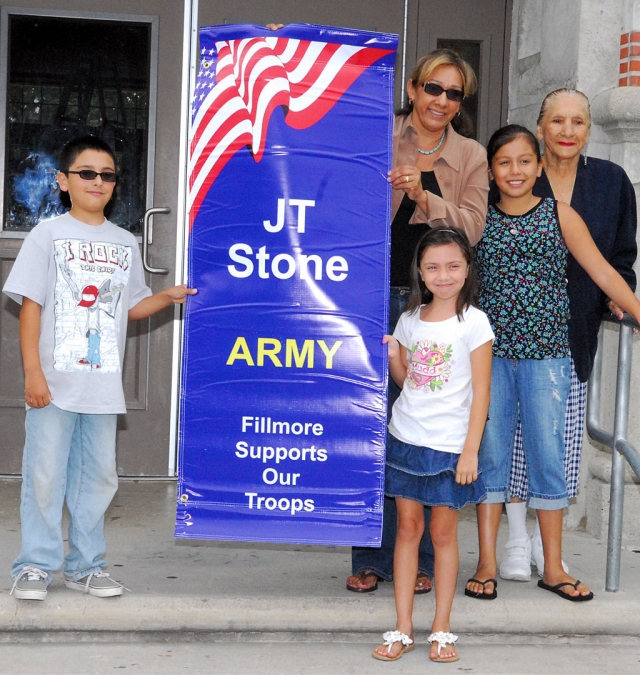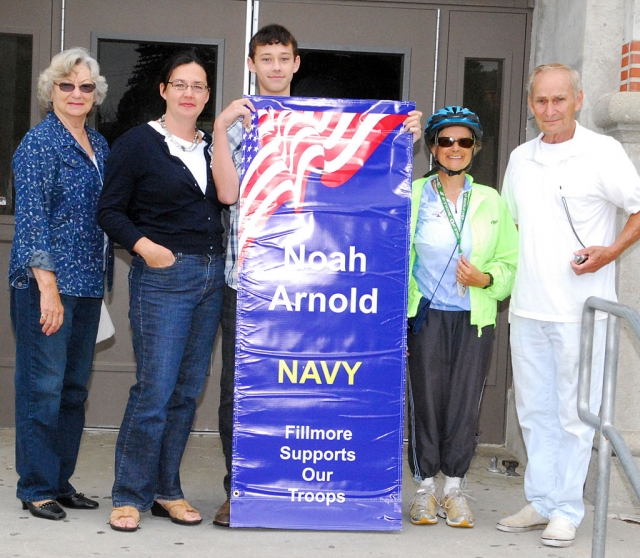|
By Anonymous — Wednesday, July 21st, 2010
 For the 10th consecutive year, Dr. Raymond Menchaca with CMH Centers for Family Health provided physicals for Fillmore Youth Football and Cheer, free of charge. The Fillmore Raiders Board of Directors thanks Dr. Menchaca and all of his staff for his generosity. The Raiders provided lunch for the medical staff on Monday. Pictured top row, P.A Sendi Flores, Dr. Raymond Menchaca, P.A. Bonnie Griffin. Bottom row, (l-r) Raider players Ricky, Sammy, and Joey Holladay. Enlarge Photo |
|
By Anonymous — Wednesday, July 21st, 2010
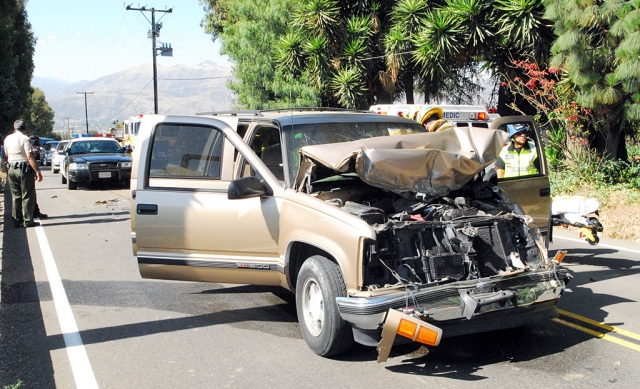 An older model GMC SUV driven by Eric Raul Hernandez, 45, of Moorpark collided with a 1979 GMC pickup Thursday afternoon on Highway 23. Hernandez was southbound, a short distance from Bardsdale Avenue when he crashed into 62 year old Fillmore resident Elioenai Estrada’s car, as she was making a left turn into a private driveway. Hernandez was transported to the Ventura County Medical Center. Estrada suffered no reported injuries. Hernandez was reported to allegedly be highly intoxicated and unconscious when transported from the scene. His vehicle suffered substantial damage. Enlarge Photo |
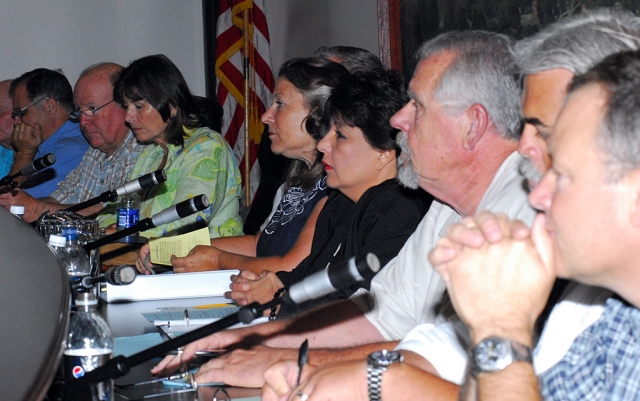 Board members squeezed into the crowded dais at the Fillmore City Council, Veterans Memorial District Joint Board Meeting. Enlarge Photo By Naomi Klimaszewska — Wednesday, July 14th, 2010
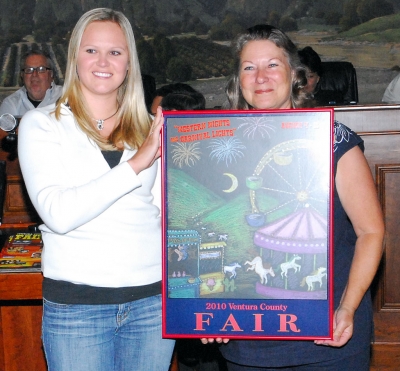 Pictured above Carolyn Mescher, with Ventura County Fairgrounds Publicity Dept., and Mayor Patti Walker displaying the VC Faire Poster 2010. Enlarge Photo City Attorney Ted Schneider reported that the City has won a legal dispute in which the owner of the El Dorado mobile home park sued the city for denying its application to convert to condominiums. The City maintained that the application was incomplete, and Judge Bysshe has ruled in its favor. Schneider noted that this is the first case of its kinds in the county, if not the state, in which a city has won such a suit. The City will wait for the application for conversion to be complete. Presentations Public Comments Special Projects Manager Linda Papas-Diaz announced an upcoming workshop in early August targeted to those involved or interested in home-based businesses. Papas-Diaz mentioned the success of the small business workshops organized through the Economic Development Collaborative of Ventura County, noting that Mimstar, a local personalized merchandise business, recently received a loan (see Gazette story). Papas-Diaz encourages the community’s participation to promote economic growth in Fillmore by networking and accessing untapped resources in the county. Marie Wren from the CONTINUED » |
|
By Anonymous — Wednesday, July 14th, 2010
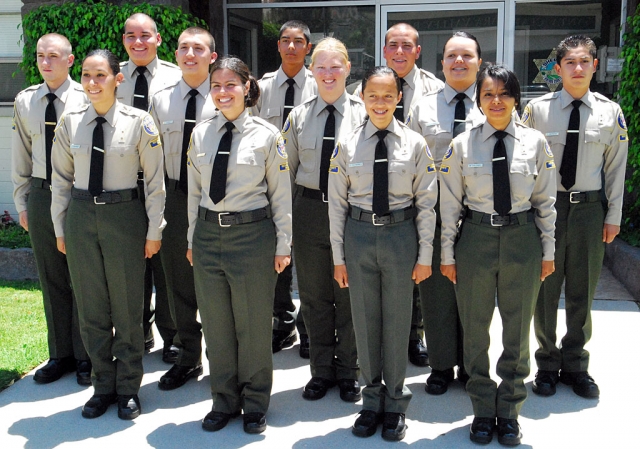 Back row: Eddie Gutierrez, Khristian Felix, Brandon Pina. Middle row: Paul Jacobs, Sergio Cornejo, Jessica Givan, Victoria Lopez, Ivan Herrera. Front row: Josefina Fernandez, Briana Vazquez, Elizabeth Gutierrez, Maria Salgago. Not pictured is Tyler Hackworth and Michael Topete. They are all heading to a three week explorer Academy. Enlarge Photo |
|
By Anonymous — Wednesday, July 14th, 2010
 Thursday, July 8th, there was another installation of banners held on the front steps of Fillmore High School. Pictured (l-r) Ethan Arnold, brother of Noah Arnold, Annette Fox, mother of J.T. Stone, Captain Brandt Klopp with his own banner, and Jim Rogers holding Joseph Mendoza’s banner. Enlarge Photo 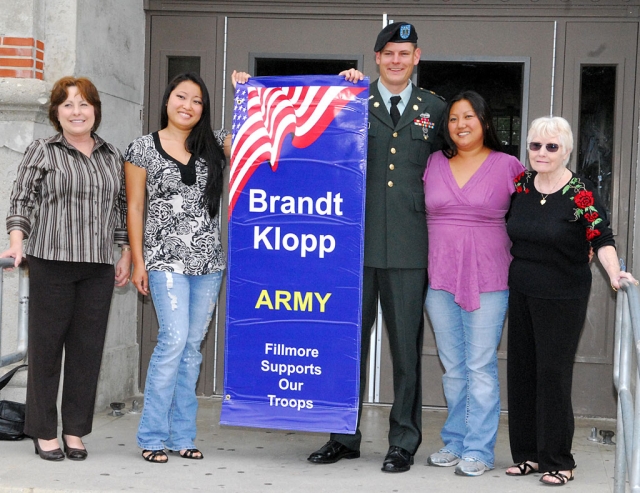 Army Captain Brandt Klopp and his family were present at the hanging of his Military Banner. Enlarge Photo 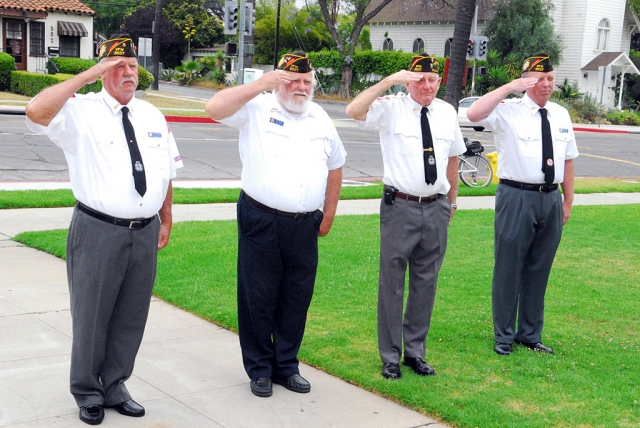 Pictured (l-r) are Vic Westerberg, Jim Mills, John Pressey, and John Hart, Veterans of Foreign Wars Post 9637, saluting at the banner hanging. Enlarge Photo  A city employee installs a banner on Central Avenue last Thursday. Take a moment and look at all of the banners; there are quit a few Fillmore citizens who are in the military. If you know of anyone who is serving in our armed forces please notify The Fillmore Gazette; we would like to do a story on them. Enlarge Photo |
|
By Anonymous — Wednesday, July 14th, 2010
July Festival results and thanks
City officials estimate that about 20,000 people ventured out to Fillmore on the 4th of July to attend the Sespe Creek Car Show & Festival, observe the horseshoe tournament, purchase safe and sane fireworks and stay for the annual spectacular fireworks display in the sky. The car show attracted approximately 220 car entries this year, down about 30% from previous years, but still substantial enough to satisfy the car enthusiast. The following entrants took home a beautifully crafted blue glass-engraved trophy for winning in their selected category. T Buckets—Tom Sheehan; Street Rods 1900-1932—Gary Larkins; Street Rods 1933-1936—Mark Pierce; Street Rods 1937-1941—Greg Chavez; Street Rods 1942-1948—Roy Tapia; Street Rods 1949-1963—Ralph Casallittas; Mustangs—Tony Rivas; 1955-1957 Chevy’s—Mike Wiener; Rat Rod—John Lynch; Rancheros—William Taylor; Corvettes—Kevin Warring; Thunderbirds—Gerald Lybolt; Sports Cars—Richard Faidley; Camaros—Gran Classics; El Camino—Jerry Jenkins; Truck-Pickyp—Kevin Warring; Stock Original 1900-1940—Pepe Gonzales; Stock Original 1941-1951—Ernie Trujillo Stock original 1952-1974—Joe Avila; Street Rod Open—Bob Boudreau; Street Rod Closed—Deuces Wild; Mild Modification—Albert Papu; Major Modification—Jerry Kransler; Muscle Cars—Eddie Arano; Most Likely to be Stopped—Nick Donwen; Under Construction—Manny Figuerea; Drag Cars—John O’Hare; Under 21—Roy Nava; Best Flames—Joe Freas. Fillmore & Western Railway, CONTINUED » |
|
By Anonymous — Wednesday, July 14th, 2010
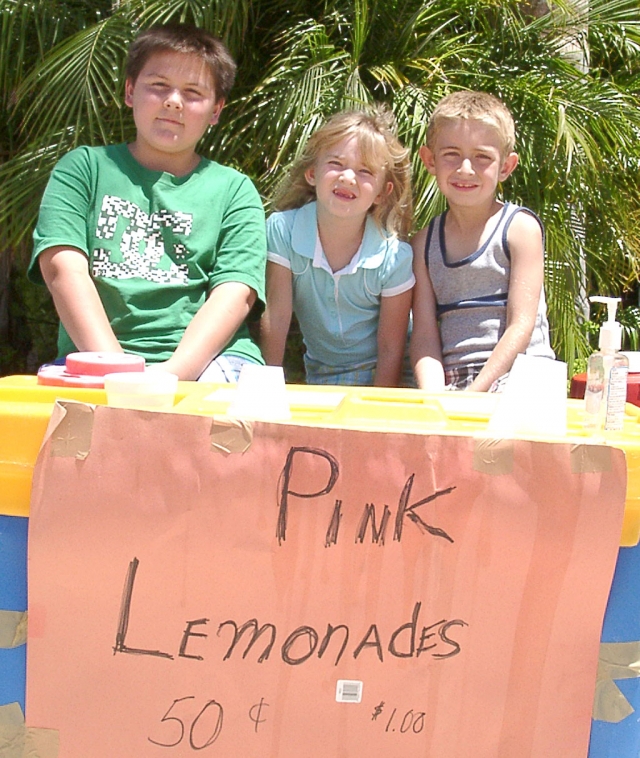 According to the three owners of this Lemonade stand in Fillmore, business on Tuesday, July 13th was brisk due to the “hot summer day in Fillmore.” The Lemonade Stand, that day, was offering their special “Pink Lemonade” in large and small sizes. According to one patron of the Lemonade Stand, “It’s the best Pink Lemonade I’ve ever had!” Enlarge Photo |
|
By Anonymous — Wednesday, July 14th, 2010
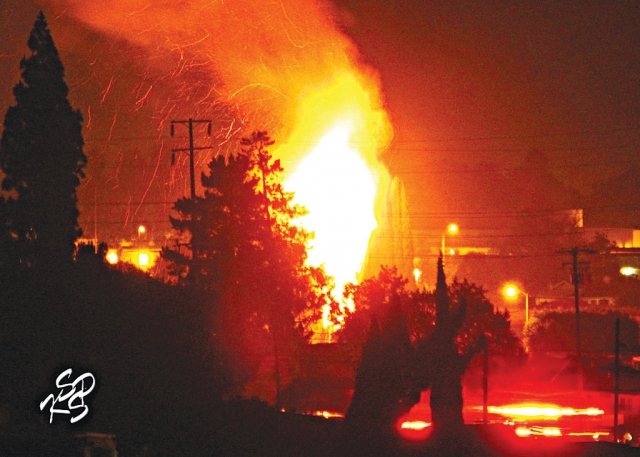 Fillmore fire Dept. responded to a reported tree fire on Boulder Street, July 4th. Upon arrival Engine 91 reported that he was on scene of several Cypress trees that were on fire next to two structures. Engine 91, Engine 191, Quint 91 and Fillmore Chief 1 responded. The fire was extinguished in about 10 minutes. Several witnesses reported that an unidentified person or persons were setting off illegal fireworks in the area where the tree fire started. Photo courtesy KSSP Photographic Studios, Fillmore. Enlarge Photo |
|
By Anonymous — Wednesday, July 14th, 2010
It must have seemed like a nice day for a drive, Sunday, July 11, when Codi Love, 18 of Fillmore, drove down the 800 Block of Edison Lane. Unfortunately, when a Sheriff’s cruiser attempted to stop her vehicle, Love fled, driving less than a mile, hitting a curb and tree. Then she stopped. Love was arrested for evading and hit-and-run. No one was injured. |
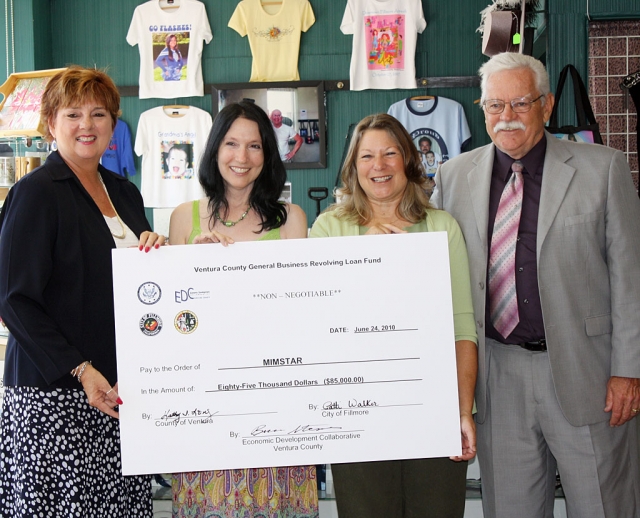 Pictured (l-r) Supervisor Kathy Long, Mimstar owner Karen Thayer, Fillmore Mayor Patti Walker, and Joe Palmer, EDC-VC loan officer, celebrate at the recent check-passing ceremony. Enlarge Photo By Anonymous — Wednesday, July 7th, 2010
Loan is the largest to a Fillmore company to date
Mimstar, a manufacturer and seller of one-of-a-kind photo items made from its customers’ photos and original artwork, has created keepsakes for countless customers since 2006. Now the Fillmore business located inside Mirage women’s clothing shop has its own keepsake, thanks to Economic Development Collaborative-Ventura County. At a check passing ceremony on June 24, Mimstar owner Karen Thayer received an $85,000 loan to be used for debt restructuring and working capital that will enable Thayer to increase her staff and the company’s production. EDC-VC is a community-based lender, and the loan is the largest it has made to a Fillmore company to date. “EDC-VC has given me wings to fly,” said Thayer. “Fillmore has been hit pretty hard with the economy, yet Mimstar is growing so much that it’s a challenge to keep up with demand. I owe a great deal of our success to EDC-VC, because they educated me about business strategies specific to my company before we even entered into the loan process. My business is my passion, and now I have the business skills to match.” Mimstar is a digital customizing business whose primary production is that of transferring customer photographs onto a multitude of items using dye sublimation, which uses special dyes and 400 degree heat to create photo-quality replications of all types of photographs on various objects. Mimstar also offers vinyl application and a digital transfer process called Chromoblast. EDC-VC is a private, nonprofit organization that serves as a business-to-government liaison to assist businesses in Ventura County by offering programs that enhance the economic vitality of the region. For more information about the Business Enhancement Program, the Revolving Loan Fund and other services available to small businesses through the EDC-VC, contact Bruce Stenslie at 805-384-1800 ext. 21 or bruce.stenslie@edc-vc.com. |



